The Press Room highlights computational astronomy work around the UC-HiPACC consortium; the wording of the short summaries on this page is based on wording in the individual releases or on the summaries on the press release page of the original source. Press releases below appear in reverse chronological order (most recent first); they can also be displayed by UC campus or DOE lab by clicking on the desired venue at the bottom of the left-hand column.
October 17, 2014 — Supercomputer helps model 3D map of adolescent Universe
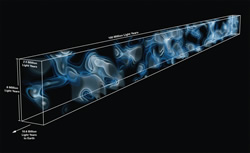
3D map of the cosmic web at a distance of 10.8 billion years from Earth, generated from imprints of hydrogen gas observed in the spectrum of 24 background galaxies behind the volume. This is the first time large-scale structures in such a distant part of the Universe have been directly mapped. Credit: Casey Stark (UC Berkeley), Khee-Gan Lee (MPIA)
NERSC press release
October 9, 2014 — Astronomers analyze atmosphere of planet orbiting another star

Exoplanet WASP-43b is a world of extremes, where seething winds howl at the speed of sound from a 3,000-degree-Fahrenheit day side, hot enough to melt steel, to a pitch-black night side with temperatures below 1,000 degrees Fahrenheit. Credit: NASA/STScI
October 2, 2014 — Astronomer Claire Max appointed interim director of UC Observatories
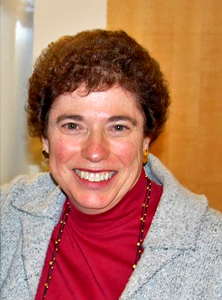
Claire Max
September 29, 2014 — Simulations reveal unusual death for ancient stars
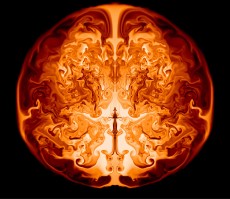
This image is a slice through the interior of a supermassive star of 55,500 solar masses along the axis of symmetry. It shows the inner helium core in which nuclear burning is converting helium to oxygen, powering various fluid instabilities (swirling lines). This snapshot from a CASTRO simulation shows one moment a day after the onset of the explosion, when the radius of the outer circle would be slightly larger than that of the orbit of the Earth around the sun. Visualizations were done in VisIT. Credit: Ken Chen
NERSC release: http://www.nersc.gov/news-publications/news/science-news/2014/simulations-reveal-unusual-death-for-ancient-stars/ ; UCSC release: http://news.ucsc.edu/2014/09/unusual-supernova.html
August 31, 2014 — Mixing in star-forming clouds explains why sibling stars look alike

Image from a computer simulation show the collision of two streams of interstellar gas, leading to gravitational collapse of the gas and the formation of a star cluster at the center. The image shows the density of interstellar gas (redder indicates greater density). Watch video at https://vimeo.com/104368279 (Credit: Y. Feng and M. Krumholz)
July 30, 2014 — Tidal forces gave moon its shape, according to new analysis
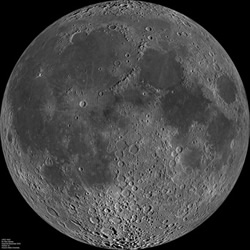
NASA's Lunar Reconnaissance Orbiter Camera acquired this image of the nearside of the moon in 2010. Credit: NASA/GSFC/Arizona State University
July 28, 2014 — Cassini finds 101 geysers and more on icy Saturn moon
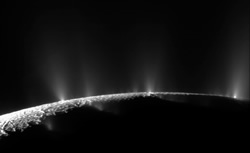
A mosaic of high resolution images from the Cassini mission shows geysers erupting from the frozen surface of Saturn's moon Enceladus. Credit: NASA/JPL/CICLOPS
July 28, 2014 — Next-generation Thirty Meter Telescope to begin construction in Hawaii
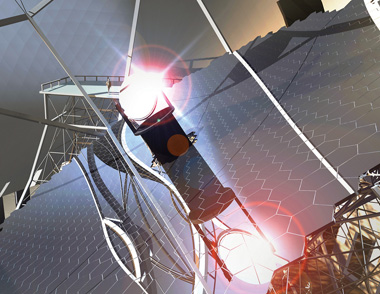
Artist’s concept shows the TMT's segmented primary mirror, which has 492 hexagonal segments. Credit: TMT Observatory Corporation
June 30, 2014 — Astrophysicist Douglas Lin wins 2014 Brouwer Award
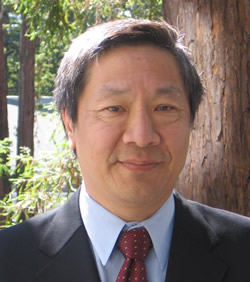
Douglas N. C. Lin
May 21, 2014 — Astronomer Enrico Ramirez-Ruiz wins fellowship at Harvard's Radcliffe Institute
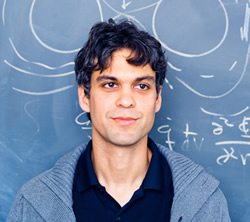
Enrico Ramirez-Ruiz (Photo by Elena Zhukova)
May 16, 2014 — Astronomer Harland Epps honored by Astronomical Society of the Pacific
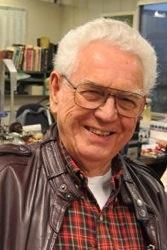
Harland Epps
April 7, 2014 — Orbital physics is child’s play with Super Planet Crash
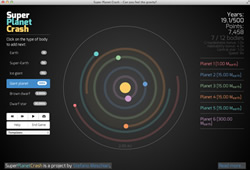
This screenshot from the online game Super Planet Crash shows a six-planet system.
March 25, 2014 — Lick’s Automated Planet Finder: First robotic telescope for planet hunters
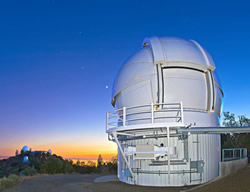
The Automated Planet Finder (APF) is the newest telescope at UC's Lick Observatory on Mt. Hamilton. (Photo by Laurie Hatch)
March 19, 2014 — Astrophysics team simulates key supernova phase at unprecedented resolution
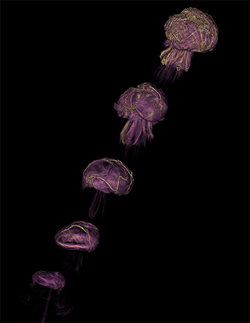
The color map shows the magnitude of vorticity (the spinning motion of the fluid), with large regions of relatively strong turbulence shown in white/yellow. More at full iSGTW press release.
18 February 2014 — When a black hole shreds a star, a bright flare tells the story
18 February 2014 — UCSC planetary scientist Ian Garrick-Bethell wins Sloan Research Fellowship
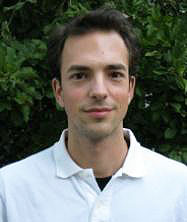
Ian Garrick-Bethell
Read full UCSC press release
January 19, 2014 — Distant quasar illuminates a filament of the cosmic web
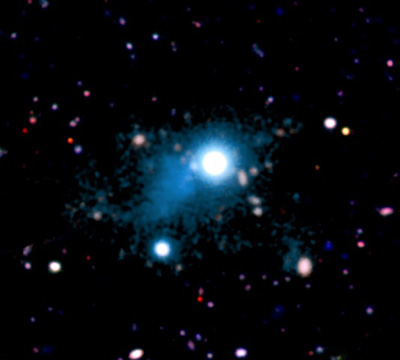
This deep image shows the nebula (cyan) extending across 2 million light-years that was discovered around the bright quasar UM287. (Image: S. Cantalupo, UCSC)
Read full UCSC press release
January 15, 2014 — Astrophysicist Piero Madau wins Dannie Heineman Prize for Astrophysics
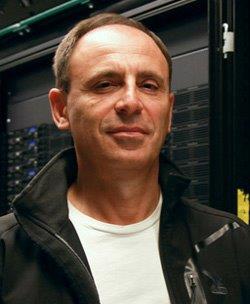
Piero Madau (Photo: C. Lagattuta)
Read full UCSC press release
January 7, 2014 — World's most powerful exoplanet camera looks skyward. Third of 3 releases about GPI.
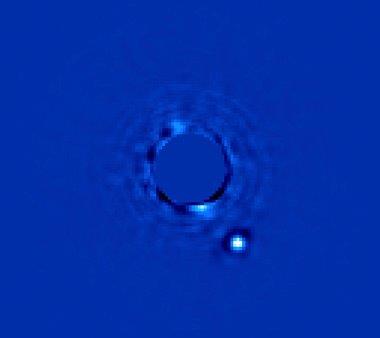
The Gemini Planet Imager's first light image of Beta Pictoris b, a planet orbiting the star Beta Pictoris. (Image credit: Processing by Christian Marois, NRC Canada)
Read full UCSC press release
January 7, 2014 — UCSC astronomers discover ultra-bright young galaxies
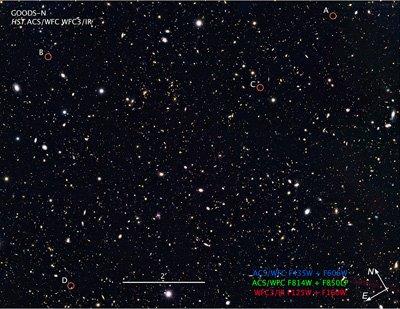
Circled in this deep image are four extremely compact and bright galaxies so distant they are seen as they existed just 500 million years after the big bang.
View full UCSC press release
December 10, 2013 — Astrophysicists launch ambitious assessment of galaxy formation simulations
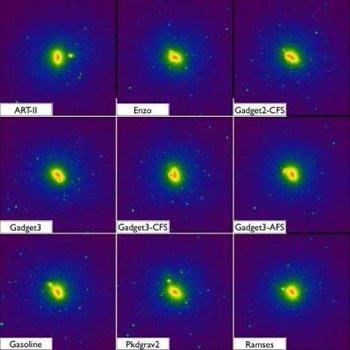
Inconsistencies in supercomputer simulations to be compared in the AGORA project are clearly evident in this test galaxy produced by each of nine different versions of participating codes using the same astrophysics and starting with the same initial conditions.
View full UCSC press release.
October 17, 2013 — Astronomers find most distant gravitational lens
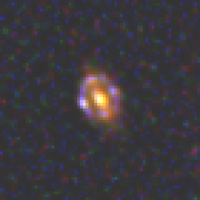
The quadruple gravitational lens J1000+0221 is the most distant strong galaxy lens discovered to date.
view full UCSC Press Release
October 17, 2013 — UCSC astrophysicist Charlie Conroy wins prestigious Packard Fellowship
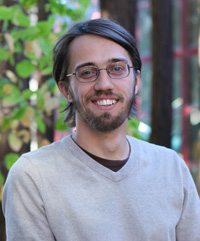
Charlie Conroy (Photo by C. Lagattuta)
view full UCSC Press Release
October 2, 2013 — Astronomers observe distant galaxy powered by primordial cosmic fuel

This image, an artist's impression based on a cosmological numerical simulation, shows a galaxy (center) with incoming cold gas flows, one of which is illuminated from behind by a distant quasar (lower left).
view full UCSC Press Release
September 30, 2013 — Astronomers find patchy clouds on exotic world
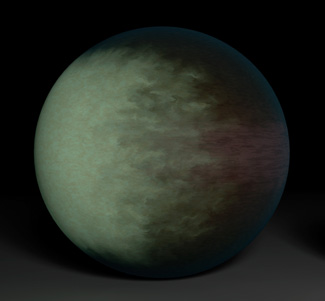
The cloud map of Kepler-7b shows that clouds cover the western side of the gaseous planet, leaving the east cloud-free.
view full UCSC Press Release
August 28, 2013 — New Cassini data from Titan indicate a rigid, weathered ice shell
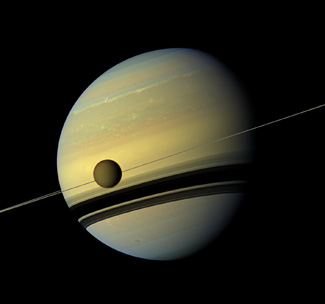
Cassini captured this image of Saturn with it's largest moon, Titan, in the foreground on August 29, 2012.
view full UCSC Press Release
August 21, 2013 — SCIPP director Steve Ritz helped ensure Fermi mission's scientific bounty
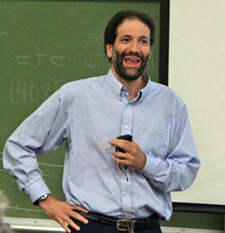
Steven Ritz, professor of physics and director of the Santa Cruz Institute for Particle Physics
view full UCSC Press Release
August 6, 2013 — Royal Astronomical Society honors astronomer Sandra Faber
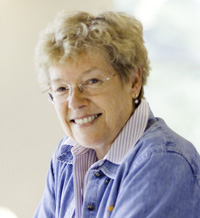
Sandra Faber
view full UCSC Press Release
July 31, 2013 — UCSC acquires powerful new astrophysics supercomputer system

The Hyades astrophysics computer system, seen from the front (left) and back (right).
view full UCSC Press Release
July 29, 2013 — Scientific authorities sign TMT master agreement

Scientific authorities of the TMT partners signed the master agreement at a meeting in Hawaii.
view full UCSC Press Release
June 25, 2013 — Astronomers detect three planets in habitable zone of nearby star

UCSC astronomer Steve Vogt (foreground) with collaborator Paul Butler at the W. M. Keck Observatory in Hawaii.
view full UCSC Press Release
May 31, 2013 — Congressman Farr honors Sandy Faber at Senate meeting
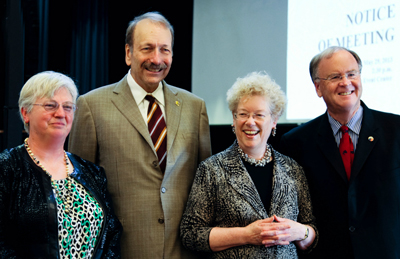
Campus Provost Alison Galloway and Chancellor George Blumenthal, both at left, join Faber and Farr to honor the moment.
view full UCSC Press Release
April 29, 2013 — Astrophysics internships bring community college students to UCSC
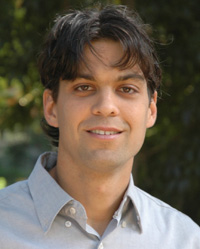
Enrico Ramirez-Ruiz
view full UCSC Press Release
April 18, 2013 — Distant blazar is a high-energy astrophysics puzzle
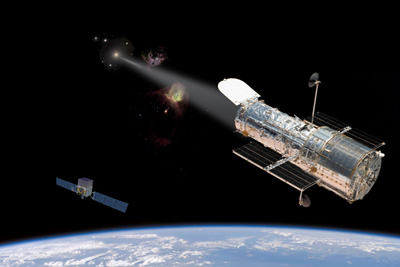
Artist's concept of the Hubble Space Telescope viewing ultraviolet light from the jet of the active galactic nucleus of PKS 1424+240. Clouds of hydrogen gas along the line of sight absorb the light at known frequencies, allowing the redshift and distance of each cloud to be determined.
view full UCSC Press Release
March 27, 2013 — UCSC and industry partners launch center for data storage research
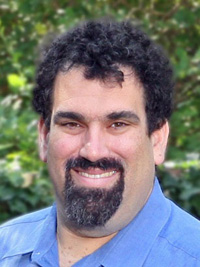
Ethan Miller, director of the Center for Research in Storage Systems at UCSC
view full UCSC Press Release
February 21, 2013 — Stellar motions in outer halo shed new light on Milky Way evolution

This illustration shows the disk of our Milky Way galaxy surrounded by a faint, extended halo of old stars. Astronomers using the Hubble Space Telescope to observe the nearby Andromeda galaxy identified a dozen foreground stars in the Milky Way halo and measured their sideways motions. Illustration Credit: NASA, ESA, and A. Feild (STScI)
view full UCSC Press Release
January 23, 2013 — Astronomer Mark Krumholz awarded AAS Warner Prize
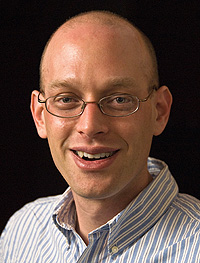
Mark Krumholz, associate professor of astronomy and astrophysics. (Photo by J. MacKenzie)
view full UCSC Press Release
December 18, 2012 — Closest single star like our Sun may have a habitable planet
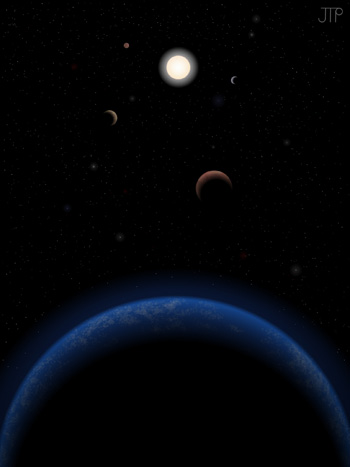
An artist's impression of the Tau Ceti system. (Image by J. Pinfield for the RoPACS network at the University of Hertfordshire, 2012)
An international team of astronomers has discovered that Tau Ceti, one of the closest and most Sun-like stars, may host five planets, including one in the star's habitable zone.
At a distance of twelve light years from Earth and visible to the naked eye in the evening sky, Tau Ceti is the closest single star that has the same spectral classification as our Sun. Its five planets are estimated to have masses between two and six times the mass of the Earth, making it the lowest-mass planetary system yet detected. One of the planets lies in the habitable zone of the star and has a mass around five times that of Earth, making it the smallest planet found to be orbiting in the habitable zone of any Sun-like star.
view full UCSC Press Release
December 17, 2012 — Top physicists gather at UCSC to honor Michael Dine and Howard Haber
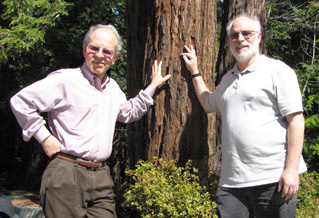
Physicists Michael Dine (left) and Howard Haber on the UCSC campus.
Dine and Haber, who are being honored on the occasion of their 60th birthdays, are both well known for their contributions to the field of theoretical high-energy physics. The symposium, "The Search for Fundamental Physics: Higgs Bosons and Supersymmetry," will take place January 4 to 6, 2013.
view full UCSC Press Release
November 29, 2012 — Physicist Robert Johnson elected Fellow of American Physical Society

Robert Johnson
Robert Johnson, professor of physics at UC Santa Cruz, has been elected a Fellow of the American Physical Society (APS) in recognition of his exceptional contributions to physics.
Johnson works in the areas of experimental particle physics and high-energy astrophysics and is associate director of the Santa Cruz Institute for Particle Physics (SCIPP). The APS citation recognizes him "for his leadership of the design and implementation of the Fermi Large Area Telescope (LAT) Tracker." The LAT is the primary instrument on NASA's Fermi Gamma-ray Space Telescope. Johnson led a SCIPP team that spent nearly 16 years working on the gamma-ray detecting system for the LAT. Since the launch of Fermi in 2008, his group has been involved in analyzing data from the instrument.
view full UCSC Press Release
October 19, 2012 — Astronomers uncover a surprising trend in galaxy evolution
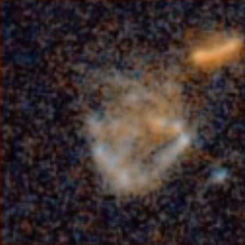
Image credit: NASA/HST
A comprehensive study of hundreds of galaxies observed by the Keck telescopes in Hawaii and NASA's Hubble Space Telescope has revealed an unexpected pattern of change that extends back 8 billion years, or more than half the age of the universe.
"Astronomers thought disk galaxies in the nearby universe had settled into their present form by about 8 billion years ago, with little additional development since," said Susan Kassin, an astronomer at NASA's Goddard Space Flight Center and the study's lead researcher. "The trend we've observed instead shows the opposite, that galaxies were steadily changing over this time period."
view full UCSC Press Release
October 18, 2012 — Violent Origin of Saturn's Oddball Moons Explained
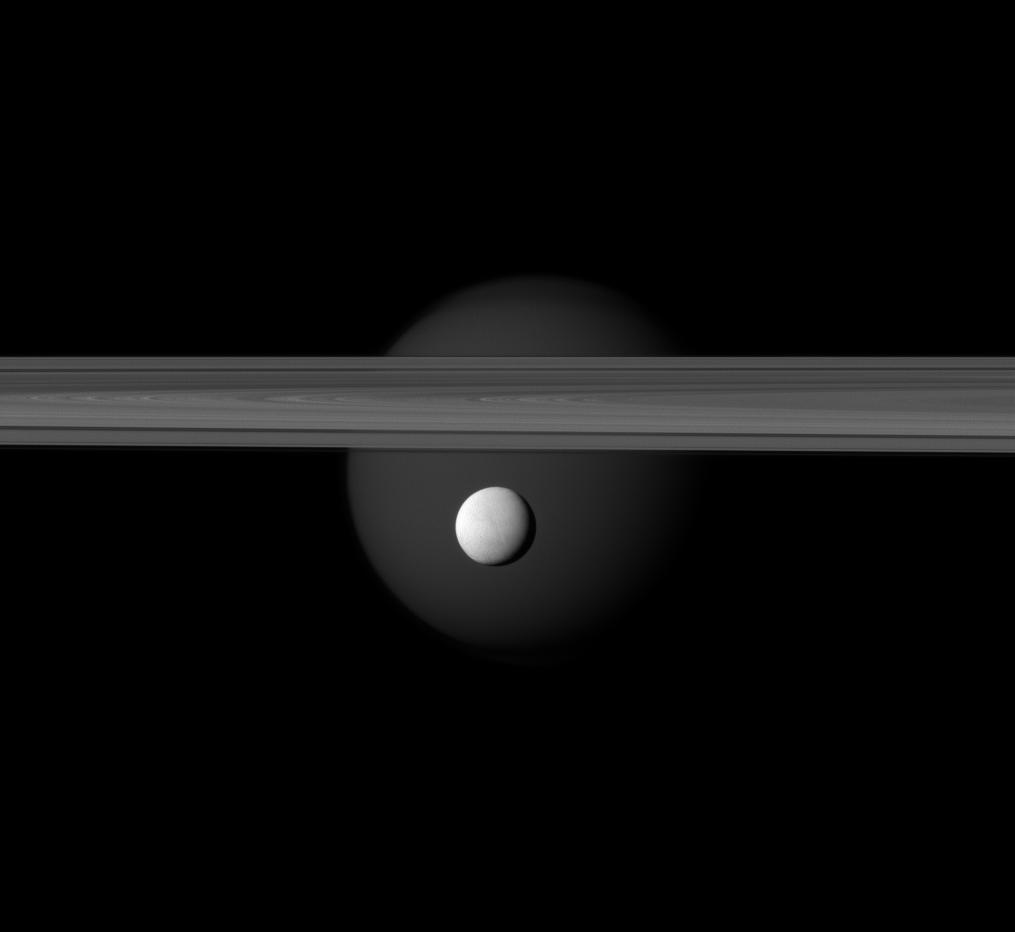
Saturn’s icy moon Enceladus hangs below the gas giant’s rings while Titan lurks in the background, in this new image taken by the Cassini spacecraft on March 12, 2012. CREDIT: NASA/JPL-Caltech/Space Science Institute
Saturn's icy medium-size moons were born when a few much bigger satellites collided to form the ringed planet's huge moon Titan, a new study suggests.
The Saturn system started out with a family of several relatively large moons like the Galilean satellites of Jupiter (Ganymede, Europa, Callisto and Io), according to the new theory. But things changed with a few dramatic moon mergers, which created the Titan we know today and shed enough material to form satellites such as Mimas, Enceladus, Tethys, Dione, Rhea and Iapetus, researchers said.
"We think that the giant planets got their satellites kind of like the sun got its planets, growing like miniature solar systems and ending with a stage of final collisions," lead author Erik Asphaug, of the University of California, Santa Cruz, said in a statement...
view full SPACE.com article
view full UCSC Press Release
October 17, 2012 — Giant impact scenario may explain the unusual moons of Saturn

Saturn's baffling diversity of moons includes, clockwise from Titan (upper right), Iapetus, Hyperion, Enceladus, Tethys, Dione, and Mimas, with Rhea in the center. (Credit: NASA/JPL/SSI; montage by E. Lakdawalla)
Among the oddities of the outer solar system are the middle-sized moons of Saturn, a half-dozen icy bodies dwarfed by Saturn's massive moon Titan. According to a new model for the origin of the Saturn system, these middle-sized moons were spawned during giant impacts in which several major satellites merged to form Titan.
Erik Asphaug, professor of Earth and planetary sciences at the University of California, Santa Cruz, will present this new hypothesis October 19 at the annual meeting of the Division for Planetary Sciences of the American Astronomical Society in Reno, Nevada. Asphaug and his coauthor, Andreas Reufer of the University of Bern, Switzerland, also describe their model in detail in a paper to be published in Icarus (in press).
view full UCSC Press Release
October 12, 2012 — Mapping the Sky

UCSC Professor of Astronomy Connie Rockosi, a member of the multi-institutional team that built the digital scanning camera for the Sloan Digital Sky Survey. (Photo courtesy Fermilab Visual Media Services)
On Friday nights,while her high school classmates were going to parties, Connie Rockosi enjoyed a different kind of celebration: star parties at her local astronomy club in Cranford, New Jersey.
One night, she saw a star disappear as it passed behind the rings of Saturn and then wink at her through a gap in the rings. Even if she couldn't see the gap directly, the reappearance of the star proved that it was there.
"It was a neat experience," she says. "It's the kind of detective work that we have to do as astronomers, because we can't go out and poke at the things we observe. We have to tell a story based on very limited and indirect observations. This was my first taste of what it's like to do science."
view full UCSC Press Release
September 25, 2012 — Hubble produces deepest ever view of the universe
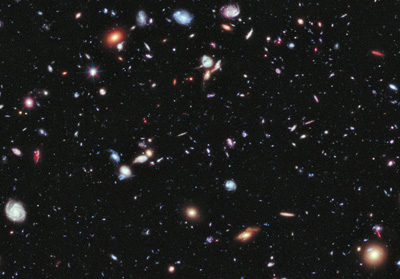
A wide variety of distant galaxies can be seen in this section of the eXtreme Deep Field (XDF). See video below. (Credit: NASA; ESA; G. Illingworth, D. Magee, and P. Oesch, UC Santa Cruz; R. Bouwens, Leiden University; and the HUDF09 Team)
Like photographers assembling a portfolio of best shots, astronomers have assembled a new, improved portrait of mankind's deepest-ever view of the universe.
Called the eXtreme Deep Field, or XDF, the photo was assembled by a team led by Garth Illingworth, professor of astronomy and astrophysics at UC Santa Cruz. The image combines 10 years of Hubble Space Telescope photographs taken of a patch of sky at the center of the original Hubble Ultra Deep Field. The size of the XDF on the sky is a small fraction of the angular diameter of the full moon...
view full UCSC Press Release
August 30, 2012 — Celebrating astronomical success at UC Santa Cruz
During this year's celebration, two major events—the Foundation Forum, featuring Martin Rees, United Kingdom's Astronomer Royal, and the 12th annual Sidhartha Maitra Memorial Lecture, featuring Sandra Faber, University Professor of Astronomy and Astrophysics professor at UCSC, will put astronomy studies in the spotlight.
UC Santa Cruz is the perfect place to host these high-profile events, considering its eminent status in this field. UCSC is one of the world's leading centers for both observational and theoretical research in astronomy and astrophysics.
Areas of special interest at UCSC include the formation and evolution of stars and galaxies, planet formation and extrasolar planets, cosmology (the origin and evolution of the universe), high-energy astrophysics, black holes, supernovae, and all aspects of observational optical and infrared astronomy..."
view full UCSC Press Release
July 11, 2012 — Dark galaxies of the early universe spotted for the first time
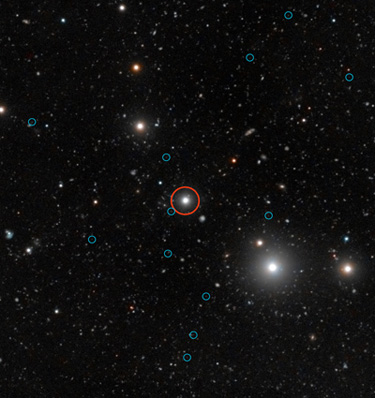
This deep image shows the region of the sky around the quasar HE0109-3518 (labeled with a red circle near the centre of the image). The energetic radiation of the quasar makes dark galaxies glow. The faint images of the glow from 12 dark galaxies are labeled with blue circles. Image credit: ESO, Digitized Sky Survey 2, and S. Cantalupo (UCSC)
"For the first time, dark galaxies--an early phase of galaxy formation, predicted by theory but unobserved until now--may have been spotted. These objects are essentially gas-rich galaxies without stars. An international team has reported the possible detection of these elusive objects by observing them glowing as they are illuminated by a quasar. The team published their results in a paper in the journal Monthly Notices of the Royal Astronomical Society.
"After several years of attempts to detect fluorescent emission from dark galaxies, our results demonstrate the potential of our method to discover and study these fascinating and previously invisible objects," said lead author Sebastiano Cantalupo, a postdoctoral researcher at UC Santa Cruz..."
view full UCSC Press Release
June 13, 2012 — Astronomer Jerry Nelson receives Franklin Medal in campus ceremony
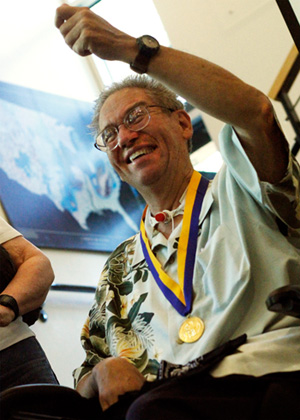
Jerry Nelson at the award ceremony in his honor. (Photos by E. Arvizu)
Astronomer Jerry Nelson received the Franklin Institute's 2012 Benjamin Franklin Medal in Electrical Engineering in a ceremony at UC Santa Cruz on Friday, June 8.
The Franklin Institute Awards are among the oldest and most prestigious comprehensive science awards in the world. Frederic Bertley, vice president for science and innovation at the Franklin Institute, traveled to UC Santa Cruz to present Nelson's medal to him in person. Nelson, a professor of astronomy and astrophysics at UCSC, was unable to travel to the Franklin Institute in Philadelphia for an awards ceremony and related events in April.
UCSC Chancellor George Blumenthal and astronomer Sandra Faber both shared memories of working with Nelson over the years in remarks before a large crowd of astronomy faculty and students at the Center for Adaptive Optics. Faber, winner of the Franklin Institute's 2009 Bower Award and Prize for Achievement in Science, joked that the institute "once again has shown excellent taste in choosing award winners."
http://news.ucsc.edu/2012/06/nelson-medal.html
June 01, 2012 — Astronomer Sandra Faber receives prestigious Bruce Gold Medal
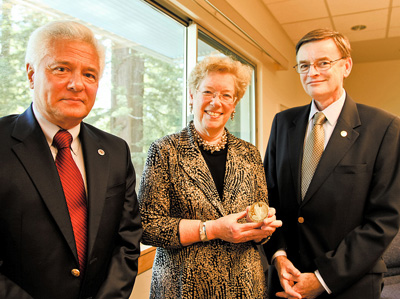
UCSC astronomer Sandra Faber (center) received the 2012 Catherine Wolfe Bruce Gold Medal from William Gutsch (left), board president of the Astronomical Society of the Pacific, and ASP executive director James Manning (right). Photo by Carolyn Lagattuta.
By Tim Stephens
The Astronomical Society of the Pacific (ASP), one of the oldest and most respected astronomy societies in the United States, has awarded the 2012 Catherine Wolfe Bruce Gold Medal to Sandra Faber, University Professor of astronomy and astrophysics at UC Santa Cruz. The award recognizes Faber for her lifetime achievements in astronomical research.
ASP executive director James Manning and ASP board president William Gutsch came to UC Santa Cruz on Thursday, May 31, to present the medal to Faber in a ceremony at the Center for Adaptive Optics. "Professor Faber has influenced observational cosmology in extraordinary ways over the past 30 years," Manning said. "We are very pleased to recognize her achievements and hope that her remarkable career serves to inspire those who wish to explore and seek greater understanding of our world and the worlds around us."...
view full UCSC Press Release
May 31, 2012 — Milky Way destined for head-on collision with Andromeda galaxy
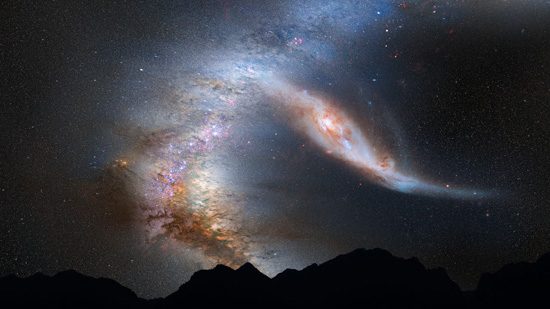
The night sky 4 billion years from now would look something like this as the Andromeda galaxy begins to collide and merge with the Milky Way. The image is based on dynamical computer modeling of the future collision between the two galaxies. Illustration Credit: NASA, ESA, Z. Levay (STScI), and O. Mellinger.
Our galactic neighbor the Andromeda galaxy is on a collision course with our own Milky Way galaxy, according to new observations by a team of astronomers using the Hubble Space Telescope.
Also called M31, the Andromeda galaxy is the closest spiral galaxy to the Milky Way and the largest in the local group of galaxies.
Painstaking measurements of its motion show that it will collide with the Milky Way about 4 billion years from now. M31 is now 2.5 million light-years away, but inexorably drifting ever nearer to us under the mutual pull of gravity between the two galaxies.
Puragra Guhathakurta, professor of astronomy and astrophysics at UC Santa Cruz, said astronomers have long speculated that the two galaxies would eventually collide. "Now we've shown that a collision is inevitable," he said...
view full UCSC Press Release
April 25, 2012 — Huffman Prize winner helps develop better tools for analyzing "big data"

Senior Joshua Rosen, winner of the 2012 Huffman Prize. (Photo by C. Lagattuta)
When UC Santa Cruz computer scientist Neoklis Polyzotis first had Joshua Rosen as a student in one of his classes, he initially thought Rosen was a graduate student taking the class as a refresher. "Josh was head and shoulders above his classmates in terms of his understanding of the material, his ability to think critically, and his technical prowess," said Polyzotis, an associate professor of computer science in the Baskin School of Engineering.
In fact, Rosen was not a graduate student, but a junior transfer from Cabrillo College who happened to have an exceptional aptitude for computer science. Polyzotis promptly invited him to work on a research project, and before long Rosen was deeply involved in a collaborative project with researchers at UC Irvine and Yahoo Research to develop better tools for large-scale data processing. In addition to his productive engagement in this research, Rosen managed to rack up an impressive 15 A+ grades and four A's in his classes at UC Santa Cruz.
Rosen is the 2012 winner of the Huffman Prize, awarded annually to a Baskin School of Engineering graduating senior whose academic career at UCSC exhibits extraordinary creativity, depth of inquiry, and overall excellence. The Huffman Prize honors the memory and the legacy of its namesake, David A. Huffman, professor emeritus of computer science. "Joshua is a student that David Huffman would have loved to have in his class, and I'm sure Joshua would have loved learning from David," said Charlie McDowell, professor of computer science and associate dean for undergraduate affairs in the Baskin School of Engineering...
view full UCSC Press Release
April 25, 2012 — A fusion of art and science

By John C. Cannon
Last summer, visitors at the Tech Museum in San Jose had the chance to step off our planet and hurl a star into the cosmos.
On a screen in front of them lay a black hole waiting to yank in an errant star that visitors attempted to throw toward it at just the right angle and speed. A star isn’t sucked in and gobbled up by a black hole very often—in real life, only once every hundred thousand years or so. But when a museum visitor’s thrown star was destroyed—what astronomers refer to as “tidal disruption”—the screen on the wall exploded in a concussive burst of red light.
Using a Nintendo Wii remote connecting the user to the display, the game was just one result of collaborations between scientists and artists from UC Santa Cruz through a project called OpenLab.
The idea of OpenLab is simple: Bring together a group of specialists from different disciplines and task them with leveraging each other’s strengths to create new ways to visualize scientific research. What often results is a uniquely interactive work of art that changes the way its viewers think about difficult-to-understand concepts. In this case, “They will remember forever that they themselves disrupted a star,” says Enrico Ramirez-Ruiz, associate professor of astronomy and astrophysics, who co-founded OpenLab...
view full UCSC review
April 3, 2012 — Kepler Explorer app puts distant planets at your fingertips
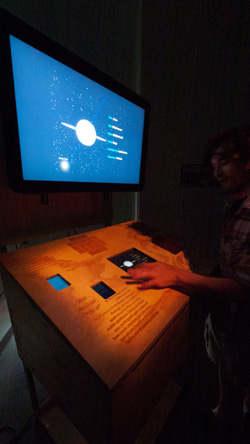
The Kepler Explorer app is part of an exhibit to be installed at the Lick Observatory visitors gallery.
Armchair explorers of the cosmos can now have at their fingertips the nearly 2,000 distant planetary systems discovered by NASA's Kepler Mission. Kepler Explorer, an innovative app for iPads and iPhones developed by a team at the University of California, Santa Cruz, provides interactive displays of newly discovered planetary systems based on Kepler data.
Now available for free from the iTunes App Store, Kepler Explorer was developed through the OpenLab initiative at UC Santa Cruz, which brought together faculty and students in astrophysics, art, and technology for a summer institute last year. The Kepler Explorer team includes astrophysicist Jonathan Fortney, a member of the Kepler science team; two of his graduate students, Eric Lopez and Caroline Morley; artist Kyle McKinley, a recent graduate of the Digital Arts and New Media program; and John Peters, a recent graduate of the computer game design program.
"I learned a lot about astrophysics from this project. It was a lot of fun," said Peters, who wrote all of the software code for the app...
view full UCSC Press Release
February 08, 2012 — New images capture 'stealth merger' of dwarf galaxies
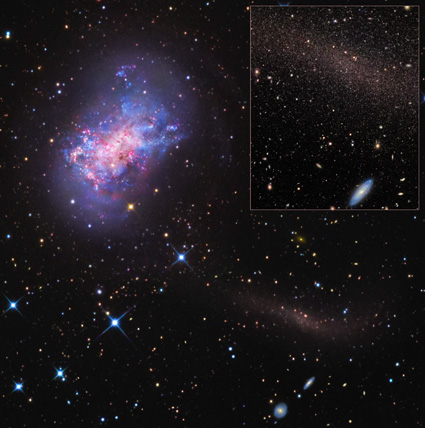
The dwarf galaxy NGC 4449 is the first dwarf galaxy with an identified stellar stream (faintly seen at the lower right, and in inset). The star stream represents the remains of a smaller satellite galaxy merging with NGC 4449. The inset image shows the stream resolved into red giant stars. Image credit and copyright: R. Jay Gabany (Black Bird Obs.); Insert credit: Subaru/Suprime-Cam (NAOJ).
New images of a nearby dwarf galaxy have revealed a dense stream of stars in its outer regions, the remains of an even smaller companion galaxy in the process of merging with its host. The host galaxy, known as NGC 4449, is the smallest primary galaxy in which a stellar stream from an ongoing merger has been identified and studied in detail.
view UCSC Press Release
February 02, 2012 — New super-Earth detected within the habitable zone of a nearby star
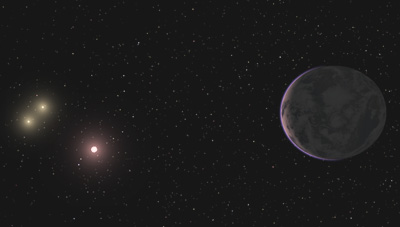
The newly discovered planet is depicted in this artist's conception, showing the host star as part of a triple-star system. The diagram below shows the orbits of the detected planets around the host star in relation to the habitable zone. (Images courtesy of Guillem Anglada-Escudé, Carnegie Institution)
January 26, 2012 — NASA's Kepler mission announces 11 planetary systems hosting 26 planets
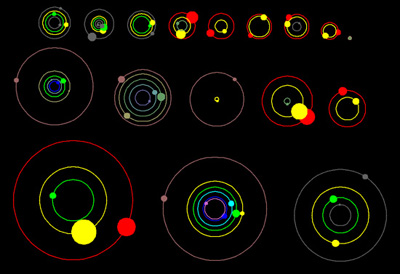
This image (from video below) shows the known planetary systems with more than one planet transiting. Credit: Daniel Fabrycky.
NASA's Kepler mission has discovered 11 new planetary systems hosting 26 confirmed planets. These discoveries nearly double the number of verified Kepler planets and triple the number of stars known to have more than one planet that transits, or passes in front of, its host star. Such systems will help astronomers better understand how planets form...
January 09, 2012 — Wandering stars offer clues to history of our galaxy
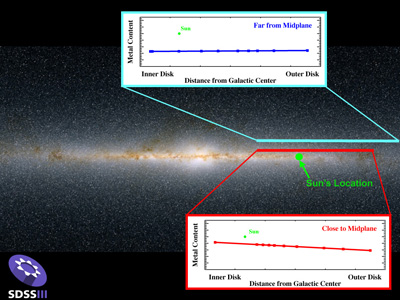
Measurements of the metal content of stars in the disk of our galaxy. The bottom panel shows the decrease in metal content as the distance from the galactic center increases for stars near the plane of the Milky Way disk. In contrast, the metal content for stars far above the plane, shown in the upper panel, is nearly constant at all distances from the center of the Galaxy. Image Credit: Judy Cheng and Connie Rockosi (UCSC) and the 2MASS Survey.
For more than a decade, the Sloan Digital Sky Survey (SDSS) has been mapping the stars in our galaxy. At the American Astronomical Society meeting this week in Austin, Texas, UC Santa Cruz astronomers Judy Cheng and Connie Rockosi presented new evidence that will help answer long-standing questions about the history of the stars in the disk of our galaxy...
December 22, 2011 — Astronomers' pristine gas discovery among top scientific breakthroughs of 2011
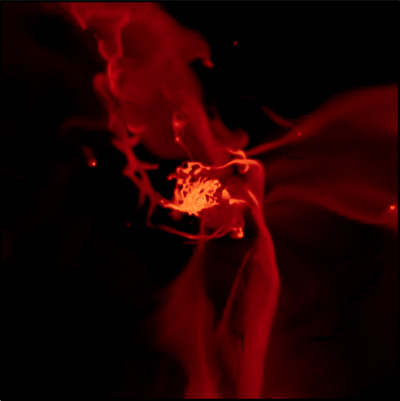
The newly discovered gas clouds may be part of a "cold flow" of gas similar to the streams seen in this simulation by Ceverino, Dekel, and Primack.
Related article: Astronomers find clouds of primordial gas from the early universe. (Nov. 10, 2011)
December 19, 2011 — UC Santa Cruz astronomer Jerry Nelson to receive 2012 Franklin Medal
The Franklin Institute in Philadelphia has announced that Jerry Nelson, professor of astronomy and astrophysics at UC Santa Cruz, will receive the 2012 Benjamin Franklin Medal in Electrical Engineering.
Nelson is internationally renowned as a developer of innovative designs for advanced telescopes. The Franklin Institute is honoring him "for his pioneering contributions to the development of segmented-mirror telescopes."...
December 02, 2011 — Astrophysicist Enrico Ramirez-Ruiz named to Silicon Valley's '40 Under 40'
Astrophysicist Enrico Ramirez-Ruiz is among 40 "rising stars" in Silicon Valley recognized by the Silicon Valley/San Jose Business Journal. A special "40 Under 40" feature in the December 2 issue of the Business Journal includes profiles of the honorees, who are recognized for their accomplishments and the impact they have on their communities...
November 09, 2011 — Ancient lunar dynamo may explain magnetized moon rocks
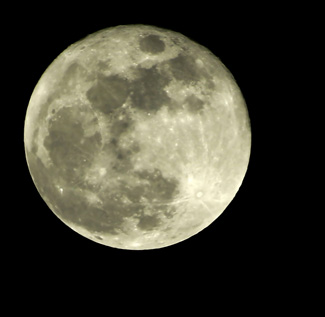
The moon may have had a magnetic field early in its history. Photo by Monica Murphy.
November 3, 2011 — Fermi telescope adds surprising new pulsars to growing collection
Scientists at Santa Cruz Institute for Particle Physics contributed to new findings.
An international team of scientists using NASA's Fermi Gamma-ray Space Telescope has discovered a surprisingly powerful millisecond pulsar that challenges existing theories about how these objects form. At the same time, another team has located nine new gamma-ray pulsars in Fermi data, using improved analytical techniques.
September 29, 2011 — Three "Bolshoi" Supercomputer Simulations of the Evolution of the Universe Announced by Authors from University of California, New Mexico State Universit
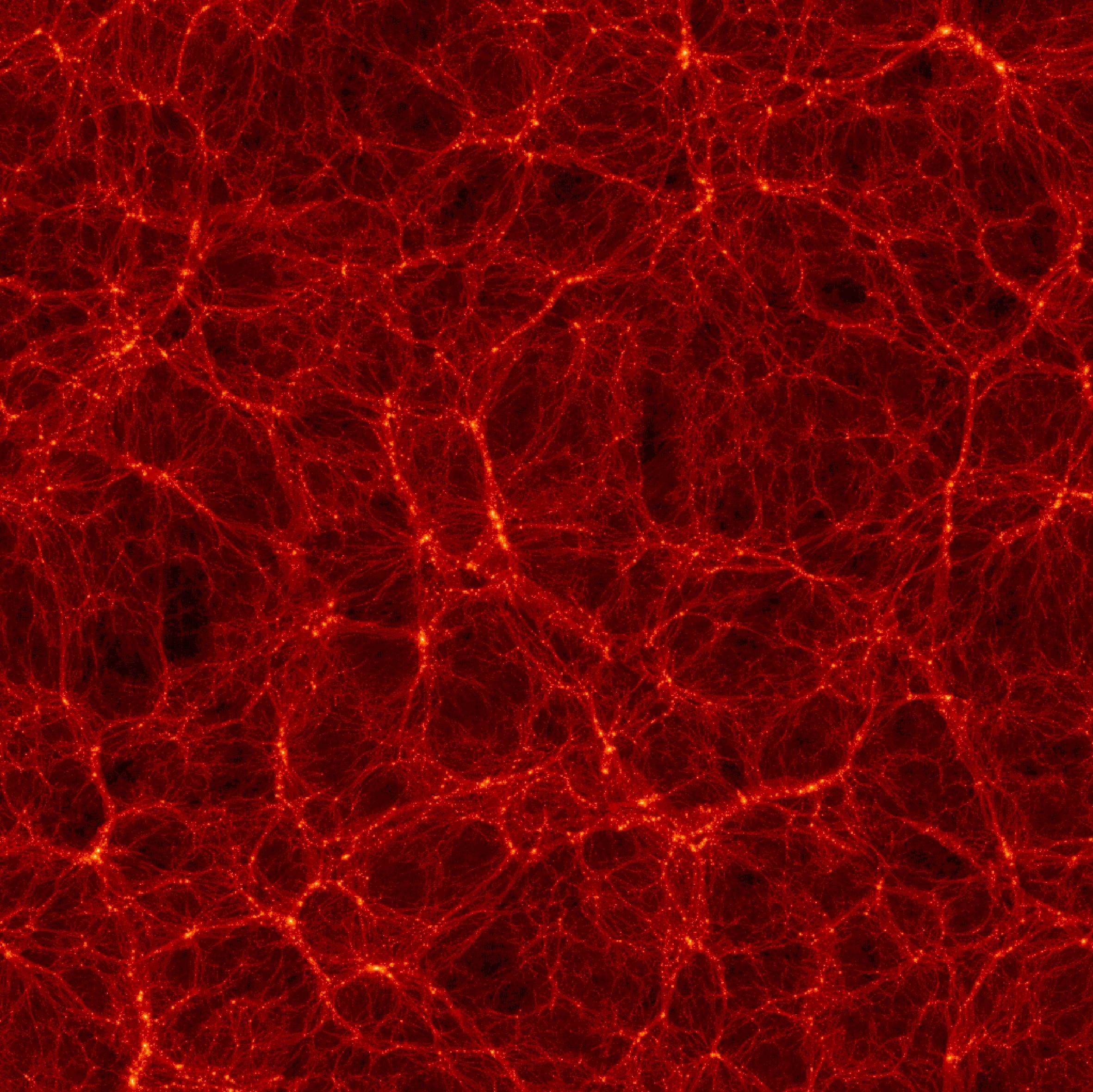
View the UC-HiPACC Press Release
View the UCSC Press Release
View the NMSU Press Release
View the NASA Ames Press Release
Visit the Bolshoi Simulations Website
